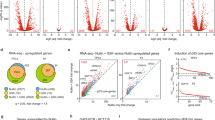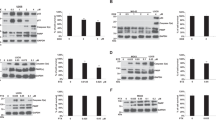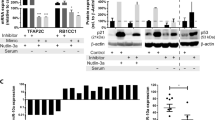Abstract
Activation of the phosphatidylinositol-3 kinase/Akt/mammalian target of the rapamycin (PI3K/Akt/mTOR) pathway and inactivation of wild-type p53 by murine double minute 2 homologue (Mdm2) overexpression are frequent molecular events in acute myeloid leukemia (AML). We investigated the interaction of PI3K/Akt/mTOR and p53 pathways after their simultaneous blockade using the dual PI3K/mTOR inhibitor PI-103 and the Mdm2 inhibitor Nutlin-3. We found that PI-103, which itself has modest apoptogenic activity, acts synergistically with Nutlin-3 to induce apoptosis in a wild-type p53-dependent fashion. PI-103 synergized with Nutlin-3 to induce Bax conformational change and caspase-3 activation, despite its inhibitory effect on p53 induction. The PI-103/Nutlin-3 combination caused profound dephosphorylation of 4E-BP1 and decreased expression of many proteins including Mdm2, p21, Noxa, Bcl-2 and survivin, which can affect mitochondrial stability. We suggest that PI-103 actively enhances downstream p53 signaling and that a combination strategy aimed at inhibiting PI3K/Akt/mTOR signaling and activating p53 signaling is potentially effective in AML, where TP53 mutations are rare and downstream p53 signaling is intact.
This is a preview of subscription content, access via your institution
Access options
Subscribe to this journal
Receive 12 print issues and online access
$259.00 per year
only $21.58 per issue
Buy this article
- Purchase on Springer Link
- Instant access to full article PDF
Prices may be subject to local taxes which are calculated during checkout







Similar content being viewed by others
Accession codes
References
Parcellier A, Tintignac LA, Zhuravleva E, Hemmings BA . PKB and the mitochondria: AKTing on apoptosis. Cell Signal 2008; 20: 21–30.
Mamane Y, Petroulakis E, LeBacquer O, Sonenberg N . mTOR, translation initiation and cancer. Oncogene 2006; 25: 6416–6422.
Martelli AM, Nyåkern M, Tabellini G, Bortul R, Tazzari PL, Evangelisti C et al. Phosphoinositide 3-kinase/Akt signaling pathway and its therapeutical implications for human acute myeloid leukemia. Leukemia 2006; 20: 911–928.
Samuels Y, Ericson K . Oncogenic PI3K and its role in cancer. Curr Opin Oncol 2006; 18: 77–82.
Song G, Ouyang G, Bao S . The activation of Akt/PKB signaling pathway and cell survival. J Cell Mol Med 2005; 9: 59–71.
Xu Q, Simpson SE, Scialla TJ, Bagg A, Carroll M . Survival of acute myeloid leukemia cells requires PI3 kinase activation. Blood 2003; 102: 972–980.
Min YH, Eom JI, Cheong JW, Maeng HO, Kim JY, Jeung HK et al. Constitutive phosphorylation of Akt/PKB protein in acute myeloid leukemia: its significance as a prognostic variable. Leukemia 2003; 17: 995–997.
Grandage VL, Gale RE, Linch DC, Khwaja A . PI3-kinase/Akt is constitutively active in primary acute myeloid leukaemia cells and regulates survival and chemoresistance via NF-kappaB, MAPkinase and p53 pathways. Leukemia 2005; 19: 586–594.
Bardet V, Tamburini J, Ifrah N, Dreyfus F, Mayeux P, Bouscary D et al. Single cell analysis of phosphoinositide 3-kinase/Akt and ERK activation in acute myeloid leukemia by flow cytometry. Haematologica 2006; 91: 757–764.
Kornblau SM, Womble M, Qiu YH, Jackson CE, Chen W, Konopleva M et al. Simultaneous activation of multiple signal transduction pathways confers poor prognosis in acute myelogenous leukemia. Blood 2006; 108: 2358–2365.
Tamburini J, Elie C, Bardet V, Chapuis N, Park S, Broët P et al. Constitutive phosphoinositide 3-kinase/Akt activation represents a favorable prognostic factor in de novo acute myelogenous leukemia patients. Blood 2007; 110: 1025–1028.
Hollstein M, Sidransky D, Vogelstein B, Harris CC . p53 mutations in human cancers. Science 1991; 253: 49–53.
Faderl S, Kantarjian HM, Estey E, Manshouri T, Chan CY, Rahman Elsaied A et al. The prognostic significance of p16(INK4a)/p14(ARF) locus deletion and MDM-2 protein expression in adult acute myelogenous leukemia. Cancer 2000; 89: 1976–1982.
Seliger B, Papadileris S, Vogel D, Hess G, Brendel C, Störkel S et al. Analysis of the p53 and MDM-2 gene in acute myeloid leukemia. Eur J Haematol 1996; 57: 230–240.
Bueso-Ramos CE, Yang Y, deLeon E, McCown P, Stass SA, Albitar M . The human MDM-2 oncogene is overexpressed in leukemias. Blood 1993; 82: 2617–2623.
Moll UM, Petrenko O . The MDM2-p53 interaction. Mol Cancer Res 2003; 1: 1001–1008.
Wong S, McLaughlin J, Cheng D, Zhang C, Shokat KM, Witte ON . Sole BCR-ABL inhibition is insufficient to eliminate all myeloproliferative disorder cell populations. Proc Natl Acad Sci USA 2004; 101: 17456–17461.
Kojima K, Konopleva M, Samudio IJ, Ruvolo V, Andreeff M . MEK inhibition enhances nuclear proapoptotic function of p53 in AML cells. Cancer Res 2007; 67: 3210–3219.
Konopleva M, Contractor R, Tsao T, Samudio I, Ruvolo PP, Kitada S et al. Mechanisms of apoptosis sensitivity and resistance to the BH3 mimetic ABT-737 in acute myeloid leukemia. Cancer Cell 2006; 10: 375–388.
Tamburini J, Chapuis N, Bardet V, Park S, Sujobert P, Willems L et al. Mammalian target of rapamycin (mTOR) inhibition activates phosphatidylinositol 3-kinase/Akt by up-regulating insulin-like growth factor-1 receptor signaling in acute myeloid leukemia: rationale for therapeutic inhibition of both pathways. Blood 2008; 111: 379–382.
Fan QW, Knight ZA, Goldenberg DD, Yu W, Mostov KE, Stokoe D et al. A dual PI3 kinase/mTOR inhibitor reveals emergent efficacy in glioma. Cancer Cell 2006; 9: 341–349.
Vassilev LT, Vu BT, Graves B, Carvajal D, Podlaski F, Filipovic Z et al. In vivo activation of the p53 pathway by small-molecule antagonists of MDM2. Science 2004; 303: 844–848.
Kojima K, Konopleva M, Samudio IJ, Shikami M, Cabreira-Hansen M, McQueen T et al. MDM2 antagonists induce p53-dependent apoptosis in AML: implications for leukemia therapy. Blood 2005; 106: 3150–3159.
Verhaegen M, Bauer JA, Martín de la Vega C, Wang G, Wolter KG, Brenner JC et al. A novel BH3 mimetic reveals a mitogen-activated protein kinase-dependent mechanism of melanoma cell death controlled by p53 and reactive oxygen species. Cancer Res 2006; 66: 11348–11359.
Kojima K, Konopleva M, McQueen T, O'brien S, Plunkett W, Andreeff M . Mdm2 inhibitor Nutlin-3a induces p53-mediated apoptosis by transcription-dependent and transcription-independent mechanisms and may overcome Atm-mediated resistance to fludarabine in chronic lymphocytic leukemia. Blood 2006; 108: 993–1000.
Chipuk JE, Bouchier-Hayes L, Kuwana T, Newmeyer DD, Green DR . PUMA couples the nuclear and cytoplasmic proapoptotic function of p53. Science 2005; 309: 1732–1735.
Desagher S, Osen-Sand A, Nichols A, Eskes R, Montessuit S, Lauper S et al. Bid-induced conformational change of Bax is responsible for mitochondrial cytochrome c release during apoptosis. J Cell Biol 1999; 144: 891–901.
Kojima K, Konopleva M, Samudio IJ, Schober WD, Bornmann WG, Andreeff M . Concomitant inhibition of MDM2 and Bcl-2 protein function synergistically induce mitochondrial apoptosis in AML. Cell Cycle 2006; 5: 2778–2786.
Ashcroft M, Ludwig RL, Woods DB, Copeland TD, Weber HO, MacRae EJ et al. Phosphorylation of HDM2 by Akt. Oncogene 2002; 21: 1955–1962.
Pause A, Belsham GJ, Gingras AC, Donzé O, Lin TA, Lawrence Jr JC et al. Insulin-dependent stimulation of protein synthesis by phosphorylation of a regulator of 5′-cap function. Nature 1994; 371: 762–767.
Hay N . The Akt-mTOR tango and its relevance to cancer. Cancer Cell 2005; 8: 179–183.
Wullschleger S, Loewith R, Hall MN . TOR signaling in growth and metabolism. Cell 2006; 124: 471–484.
Tirado OM, Mateo-Lozano S, Notario V . Rapamycin induces apoptosis of JN-DSRCT-1 cells by increasing the Bax: Bcl-xL ratio through concurrent mechanisms dependent and independent of its mTOR inhibitory activity. Oncogene 2005; 24: 3348–3357.
Vega F, Medeiros LJ, Leventaki V, Atwell C, Cho-Vega JH, Tian L et al. Activation of mammalian target of rapamycin signaling pathway contributes to tumor cell survival in anaplastic lymphoma kinase-positive anaplastic large cell lymphoma. Cancer Res 2006; 66: 6589–6597.
Beuvink I, Boulay A, Fumagalli S, Zilbermann F, Ruetz S, O'Reilly T et al. The mTOR inhibitor RAD001 sensitizes tumor cells to DNA-damaged induced apoptosis through inhibition of p21 translation. Cell 2005; 120: 747–759.
Yamaguchi H, Wang HG . The protein kinase PKB/Akt regulates cell survival and apoptosis by inhibiting Bax conformational change. Oncogene 2001; 20: 7779–7786.
Arokium H, Ouerfelli H, Velours G, Camougrand N, Vallette FM, Manon S . Substitutions of potentially phosphorylatable serine residues of bax reveal how they may regulate its interaction with mitochondria. J Biol Chem 2007; 282: 35104–35112.
Horton LE, Bushell M, Barth-Baus D, Tilleray VJ, Clemens MJ, Hensold JO . p53 activation results in rapid dephosphorylation of the eIF4E-binding protein 4E-BP1, inhibition of ribosomal protein S6 kinase and inhibition of translation initiation. Oncogene 2002; 21: 5325–5334.
Tilleray V, Constantinou C, Clemens MJ . Regulation of protein synthesis by inducible wild-type p53 in human lung carcinoma cells. FEBS Lett 2006; 580: 1766–1770.
Herbert TP, Tee AR, Proud CG . The extracellular signal-regulated kinase pathway regulates the phosphorylation of 4E-BP1 at multiple sites. J Biol Chem 2002; 277: 11591–11596.
Chow S, Minden MD, Hedley DW . Constitutive phosphorylation of the S6 ribosomal protein via mTOR and ERK signaling in the peripheral blasts of acute leukemia patients. Exp Hematol 2006; 34: 1183–1191.
McCubrey JA, Steelman LS, Abrams SL, Bertrand FE, Ludwig DE, Bäsecke J et al. Targeting survival cascades induced by activation of Ras/Raf/MEK/ERK, PI3K/PTEN/Akt/mTOR and Jak/STAT pathways for effective leukemia therapy. Leukemia 2008; 22: 708–722.
Milella M, Kornblau SM, Estrov Z, Carter BZ, Lapillonne H, Harris D et al. Therapeutic targeting of the MEK/MAPK signal transduction module in acute myeloid leukemia. J Clin Invest 2001; 108: 851–859.
Yu K, Toral-Barza L, Shi C, Zhang WG, Zask A . Response and determinants of cancer cell susceptibility to PI3K inhibitors: combined targeting of PI3K and Mek1 as an effective anticancer strategy. Cancer Biol Ther 2007; 7: 310–318.
Park S, Chapuis N, Bardet V, Willems L, Tamburini J, Knight ZA et al. PI-103, a dual inhibitor of class I phosphatidylinositide 3-kinase and mTOR, has anti-leukemic activity in acute myeloid leukemia. Blood 2007; 110: 268a. [Abstract #876].
Acknowledgements
We acknowledge Dr Maria Soengas of Department of Dermatology, University of Michigan, Ann Arbor, MI, USA for kindly providing retrovirus encoding p53-specific shRNA. KK was supported in part by grants from the Kanae Foundation For Life and Socio-Medical Science and Novartis Foundation (Japan) for the Promotion of Science, MA by the Paul and Mary Haas Chair in Genetics and a grant from NIH, CA55164 and CA100632.
Author information
Authors and Affiliations
Corresponding author
Rights and permissions
About this article
Cite this article
Kojima, K., Shimanuki, M., Shikami, M. et al. The dual PI3 kinase/mTOR inhibitor PI-103 prevents p53 induction by Mdm2 inhibition but enhances p53-mediated mitochondrial apoptosis in p53 wild-type AML. Leukemia 22, 1728–1736 (2008). https://doi.org/10.1038/leu.2008.158
Received:
Revised:
Accepted:
Published:
Issue Date:
DOI: https://doi.org/10.1038/leu.2008.158
Keywords
This article is cited by
-
Detoxified pneumolysin derivative ΔA146Ply inhibits autophagy and induces apoptosis in acute myeloid leukemia cells by activating mTOR signaling
Experimental & Molecular Medicine (2022)
-
GATA3 and MDM2 are synthetic lethal in estrogen receptor-positive breast cancers
Communications Biology (2022)
-
Resistance mechanisms to inhibitors of p53-MDM2 interactions in cancer therapy: can we overcome them?
Cellular & Molecular Biology Letters (2021)
-
MDM2 inhibition: an important step forward in cancer therapy
Leukemia (2020)
-
Therapeutic potential of GSK-J4, a histone demethylase KDM6B/JMJD3 inhibitor, for acute myeloid leukemia
Journal of Cancer Research and Clinical Oncology (2018)



